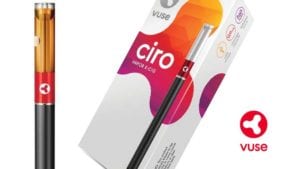Vuse Vibe, Ciro Issued U.S. Marketing Orders by FDA
- News This Week PMTA Regulation U.S. FDA
- May 12, 2022
- 7 minutes read

Credit: RJRVC

The U.S. Food and Drug Administration today issued decisions on several R.J. Reynolds Vapor Company for several Vuse branded e-cigarette products, including the authorization of six new tobacco products through the premarket tobacco product application (PMTA) pathway. It’s the second and third Vuse branded device to garner an marketing approval. The company’s top selling Alto device is still under PMTA review.
The FDA issued marketing granted orders (MGO) to for the Vuse Vibe and Vuse Ciro e-cigarette devices and accompanying tobacco-flavored closed e-liquid pods. For each device, two versions of the power units were authorized to reflect different battery manufacturers described in the company’s applications. In total, the products receiving MGOs include:
- 2 Vuse Vibe Power Units
- Vuse Vibe Tank Original 3.0%
- 2 Vuse Ciro Power Units
- Vuse Ciro Cartridge Original 1.5%
The authorization allows the products to be legally marketed in the U.S. The FDA also issued marketing denial orders to R.J. Reynolds Vapor Company for multiple other Vuse Vibe and Vuse Ciro e-cigarette products, presumably for flavors other than tobacco. Any of those products currently on the market must be removed or FDA may take enforcement action, according to the FDA.
Neither the Vibe or Ciro device is popular with vapor consumers. Many consider the products old and outdated technically, unlike Njoy’s Ace device that was granted marketing orders in April. This marks the fourth and fifth vaping product brands (Vuse has 3 seperate products under the Vuse name) to receive an MGO from the FDA. In October 2021, the FDA issued its first marketing granted orders to Vuse Solo. In late March, the agency approved several Logic products for sale in the U.S.

“Under the PMTA pathway, the applicant must demonstrate to the agency, among other things, that marketing of the new tobacco product would be appropriate for the protection of the public health.
“The authorized Vuse products were found to meet this standard because, among several key considerations, chemical testing was sufficient to determine that overall harmful and potentially harmful constituent (HPHC) levels in the aerosol of these products is lower than in combusted cigarette smoke,” the FDA explained. “Further, data provided by the applicant demonstrated that participants who had used only the authorized Vuse Vibe and Vuse Ciro products had lower levels of exposure to non-nicotine HPHCs compared to the dual users of the new products and combusted cigarettes.
“Therefore, these products have the potential to benefit adult smokers who switch completely or significantly reduce their cigarette consumption.”
The FDA said it considered the risks and benefits to the population as a whole, including users and non-users of tobacco products, especially youth. This included review of available data on the likelihood of use of the product by young people. For the authorized products, the FDA determined that the potential benefit to adult smokers who switch completely or significantly reduce their cigarette use would outweigh the risk to youth – provided that the company follows post-marketing requirements to reduce youth access and youth exposure to their marketing.
The authorization imposes strict marketing restrictions on the company to greatly reduce the potential for youth exposure to tobacco advertising for these products, according to the agency. “The FDA will closely monitor how these products are marketed and will act as necessary if the company fails to comply with any applicable statutory or regulatory requirements, or if there is a notable increase in the number of non-smokers—including youth—using these products,” it wrote.

The FDA may suspend or withdraw a marketing granted order issued under the PMTA pathway for a variety of reasons if the agency determines the continued marketing of a product is no longer “appropriate for the protection of the public health,” such as if there is a notable increase in youth initiation.
Before making marketing decision documents available to the public, the FDA must redact trade secret and confidential commercial information (CCI) and ensure documents posted to the FDA website are accessible to everyone. For these reasons, the full decision summary for marketing authorizations may not be posted to the MGO webpage until after the order issuance date, according to the agency.
In the interim, to provide as much information as possible at the time of order issuance, the FDA is making redacted versions of the order letter and the “Executive Summary” section of the decision summary available to broadly explain the public health rationale for authorization of these products.
The agency is also expected to give status reports on the remaining PMTAs that have a more than 2 percent market share according to Nielsen.
